°Arcus°
Home » Creation stories » Australia
CREATION STORIES FROM AUSTRALIA
ARRERNTE
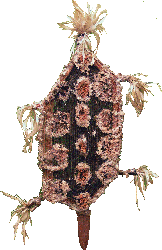
ALTJIRA
According to Carl Strehlow, the Arrernte of the region around Alice Springs knew of an eternal creator. Strehlow states that his Arrernte informants told him about one Altjira, described as a being without beginning, whose name is related to a verb form altjirerama, indicative of dreaming. Altjira, according to this construction, was the creator of the world and humanity, who appeared in the form of a large man with red skin, fair hair and the legs of an emu. He was the head of a pantheon including his dog-legged, red-skinned wives and children. He lives in the sky realm, a land above ours, whose natural features include a great river, which appears to the dwellers on earth as the Milky Way.
Of course, it must be stressed that, by the time of Strehlow's study, the Arrernte were a predominantly Christian people, which has led to some suggestions that the concept had become conflated with Christian ideas of God as Creator.
THE NUMAKULLA AND THE INAPERTWA
The Numakulla, two sky gods, created all life before assuming the shapes of lizards. The earliest of their creations were the ancestral creatures known as the Inapertwa, which were the models for plants and animals, before then being moulded into human form.
KARORA
During the Dreaming, the bandicoot spirit Karora was sleeping. From his head rose a tnatantja, a tall pole, which was alive. The top of the pole reached up into the sky. Bandicoots emerged from it and dug their way out of the earth as the sun first rose in the sky. Karora followed, cooking and killing two of them, before resting. At this point, a bullroarer emerged from under his armpit, which grew into a young man.
MANGAR-KUNJER-KUNJA
The lizard deity Mangar-kunjer-kunja was the creator of man. He discovered the Rella manerinja - the first aboriginal beings - on the side of a hill, fused together. He separated them with a knife and cut holes for their orifices, before giving them weaponry and a system of marriage.
ANKOTARINJA
One band of Arrernte, the Ngala-Mbitjana, regarded themselves as the heirs of the first man, Ankotarinja, the "Dreaming Man," who founded their culture during the Dreaming. Ankotarinja was born in the bed of a stream near Ankota.
BUNDJALUNG
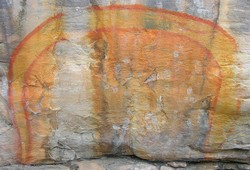
In the beginning, during the Dreaming, the Rainbow Snake - a powerful spiritual entity who features in a good many Australian myths - was guilty of a major transgression, the precise nature of which it is tabu to state. This resulted in the opposition of the creator Dirawong (Goanna), who chased the Rainbow Snake from the interior out eastwards towards the coast, which resulted in the natural features known to the Bundjalung tribes. Dirawong was regarded as the protector, guardian and helper of humanity.
GAAGUDJU (KAKADU)
Creation was ordered by the giant Wuraka, who walked through the western ocean to Allukaladi, which he created. He then moved to other parts of Australia, carrying his magnificent penis over his shoulder. Meanwhile, the Great Mother Imberombera arrived at Wungaran, where she met Wuraka. She asked where he was going and he told her he was headed towards the rising sun. He rested and Tor Rock grew at that point. Meanwhile, Imberombera carried bags and yams to Marpur where she planted the yams. She left a number of her spirit children there, before continuing to other places, giving birth to more spirit children and giving rise to many languages.
GAMILARAAY
YHI
Yhi existed during the Dreaming, and was awoke by the sound of a whistle. As her eyes opened, the previously dark cosmos was filled with light. She proceeded to wander the earth, with plants growing from her footsteps, until the world was filled with foliage.
Thereafter, Yhi was possessed with a desire to create something with the ability to dance. In search for such a thing, she looked beneath the earth, and discovered a group of demons who sought to bring about her end through song. Her warm radiance, however, caused them to flee, with the result that insects came to be. She brought them to the earth and found some caves in a mountain. Her light brought the fish and lizards into being from the warming of the ice there, as well as amphibians, mammals and birds.
Thereafter, she returned to her own world, blessing her creation with the seasons and the promise that their spirits would join her in the celestial realm after their deaths.
However, her disappearance caused darkness to return, and this caused the creatures much distress. However, she returned with the first sunrise.
Many years later, the animals had begun to long for their creator. They wanted new abilities which were granted them. At this point, she saw the first man and, realising there was nothing else like this creature, she created the first woman from a flower.
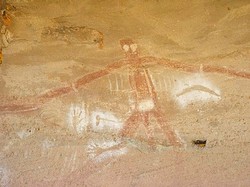
BAIAME
The Gamilaraay and their neighbours also know of another creator and sky deity by the name of Baiame, Baayami or Byamee, whose cult was restricted to male members of society. The story relates how he came down from the sky to the land, creating rivers, mountains and forests as he went, before giving the early humans instructions on how they should live and pursue their culture. He was the husband of the emu goddess Birran-gnulu or Birrahgnooloo and the father (or brother) of the shapeshifter Daramulum.
KARAJARRI (KARADJERI)
The Bagadjimbiri arose as dingos and made water holes, before fashioning sex organs from a mushroom and another fungus for the androgynous early humans. Later, they took human form and came into conflict with the quoll-man or feline Ngariman, who was irked by their laughter. Ngariman eventually slew the pair beneath the ground, only for their mother, Dilga, to flood the location with her milk, killing Ngariman and restoring the Bagadjimbiri to life. They eventually became snakes and live on as clouds.
KAURNA
During the earliest phase of human culture, the people were living peacefully, with their trading subject to the laws kept by Old Tjirbruki, an old man from the south who had fled the inundation of his land. This had resulted in the death of his nephew, who killed a female emu, thus breaking the law.
KOKOWARRA
The Kokowarra of Queensland tell a story of the dreaming which differs in many respects from other tales of this timeless time. There was, many years ago, a huge black giant. Anjir was his name. One of his most notable features was his enormous backside, which - sadly for him - had no opening. One day, a spirit by the name of Jalpan came out of the woods with a piece of quartz, which he used to bore a hole in Anjir's bottom. From this anus emerged a huge dark mass, which gave rise to the Kokowarra people. Feeling himself thus relieved, Anjir went off to another part of the country, where he lived until his death.
KULIN
At the beginning of the Dreaming, Bunjil set about creating the landscape and populating it with plants and animals, to enable humans to eke out a good life. At the end of his work, he asked Waa - who held the bag of the winds - to help him by releasing some of the winds. However, Waa's whirlwinds were insufficient for the purpose Bunjil intended, so he asked for more winds. This time, he and his two wives were blown into the sky, where Bunjil became the star Altair, with his two wives, black swans, on either side of him. His son Binbeal was the god of the rainbow.
Bunjil had asked his brother Balayang the bat to join him, but Balayang opined that Bunjil's land was too dry, suggesting instead that Bunjul join him in his land. As a result, Bunjil became angry and dispatched his helpers Djurt-djurt and Thara to set fure to Balayang's land, turning him black. The pair were, however reconciled somewhat after Balayang discovered the maidens Kunnawarra and Kururuk beneath some mud he had brought to the surface of a body of water. These were taken to Bunjil, who gave them to the men he had made as wives. Balayang was later associated with Antares.
NGARRINDJERI
During the dreaming, the great ancestor Ngurunderi made a voyage down the Murray River, seeking his two wives, who had fled from him. Ahead of him swan a gigantic fish, whose actions carved out the course of the mighty river from an unassuming stream.
Ngurunderi attempted to harpoon the fish, but failed. His spear gave rise to Lenteilin, the Long Island. A subsequent attempt proved successful, and Ngurunderi carved up his catch, which were fashioned into the different fish and peoples of the region.
Ngurunderi then made a camp, but sensed that his wives were nearby. As a result, he headed off, whereupon his canoe became the Milky Way.
The wives heard his approach and abandoned their own camp to clamber aboard a raft made from grass and reeds, which formed the patch of this vegetation at the side of Lake Albert.
Eventually, Ngurunderi reached Kingston, where he entered combat with Parampari, a wizard. The pair fought long and hard, though Ngurunderi eventually emerged victorious, burning Parampari's cadaver, which remains in the region in the form of boulders of granite.
Subsequently, Ngurunderi continued his creative ventures, forming the islands and natural features of the landscape. He caught up to his wives at Granite Island, but they fled again to Cape Jervis, before running along a land bridge - now no more - leading onto Kangaroo Island, which was cut off from the mainland after a wrathful Ngurunderi caused the waves to cover the land, drowning his wives in the process. They are now the Rocky Pages Islands.
Once the dreaming was complete, Ngurunderi rose into his canoe above.
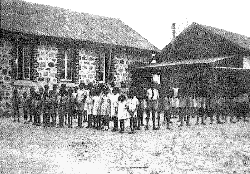
NOONGAR
Wagyl, the Rainbow Serpent, was dispatched to fashion the land between the Porongarups and Fremantle, and created the rivers and springs of the area, along with the wildlife. His body remains in the form of the Darling Scarp, while he is also associated with lakes and springs.
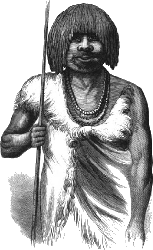
PALAWA (TASMANIA)
The earliest known deities were Parnuen and Vena, the sun and moon respectively. They were the parents of Moinee and Droemerdene, dwellers in the celestial realm.
Moinee set about bringing order and life to the primeval earth, forming the land and river systems and making the first man, Parlevar, who was given a spirit which had been present in the earth. Parlevar was not, however, a human as you and I are. Instead, his form was rather like that of the kangaroo, which was the second life form created, in the same way that Parlevar was.
Some time later, Droemerdene - identified with the star Canopus - began his work. He removed the tails from the proto-humans and gave them knee joints to enable them to rest, thus differentiating between the two primordial species.
Eventually, Moinee and Droemerdene came to blows and a great cosmic war ensued. The war was decided in favour of the latter, and Moinee was cast down from the heavens. He was transformed into a standing stone at Cox Bight. Thereafter, however, Droemerdene also fell, landing in the sea at Louisa Bay. Toogee Low at Port Davey was also regarded as a place of divine action. This inauspicious location was the home of many devils, a group who had also been enemies of Moinee.
The first men in Tasmania were also regarded in some tales as immigrants from a far off land which had later fallen prey to the sea.
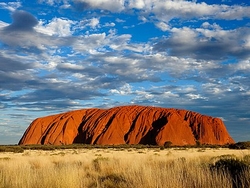
PITJANTJATJARA
Ngiṉṯaka took the form of a gigantic lizard during the Dreaming, who, together with Milpali, lived at Uluṟu. He formed the land of the Pitjantjatjara having stolen a grindstone.
YOLŊU
Barnumbirr is a creator identified with the planet Venus who guided the earliest humans to Australia. She flew east to west across the land, creating an important songline. The first humans in Australia were the Djanggawul siblings, two sisters and a younger brother, who fashioned the landscape and covered it with plants. Their original homeland was known as Baralku or Bralgu, an island east of Arnhem Land where Barnumbirr dwells, and to which the souls of the dead depart.
The Djanggawul sisters created sacred objects by breaking off parts of their vulvas, before the siblings were eaten by the rainbow snake Galeru or Galaru. They had two daughters, the Wawalag, who lived in a whirlpool and fell prey to Yurlungur, a copper snake awakened by the scent of their menstrual blood, who was later forced to regurgitate them.
Meanwhile, while the dua revere Djanggawul, the yiritja clans hold the father and son Laintjung and Banaitja in high regard. Laintjung brought the yiritja the key arts of dreaming and painting before transforming into a paper-bark tree. Banaitja was said to have emerged from the sea, where his body was flecked with foam. He taught the people the arts of life, following on from his father's gifts. He made his way to a swamp, where, having fallen asleep, he was set upon by the natives of the land, who thrust a number of spears into his flesh, killing him, only to repent later.
